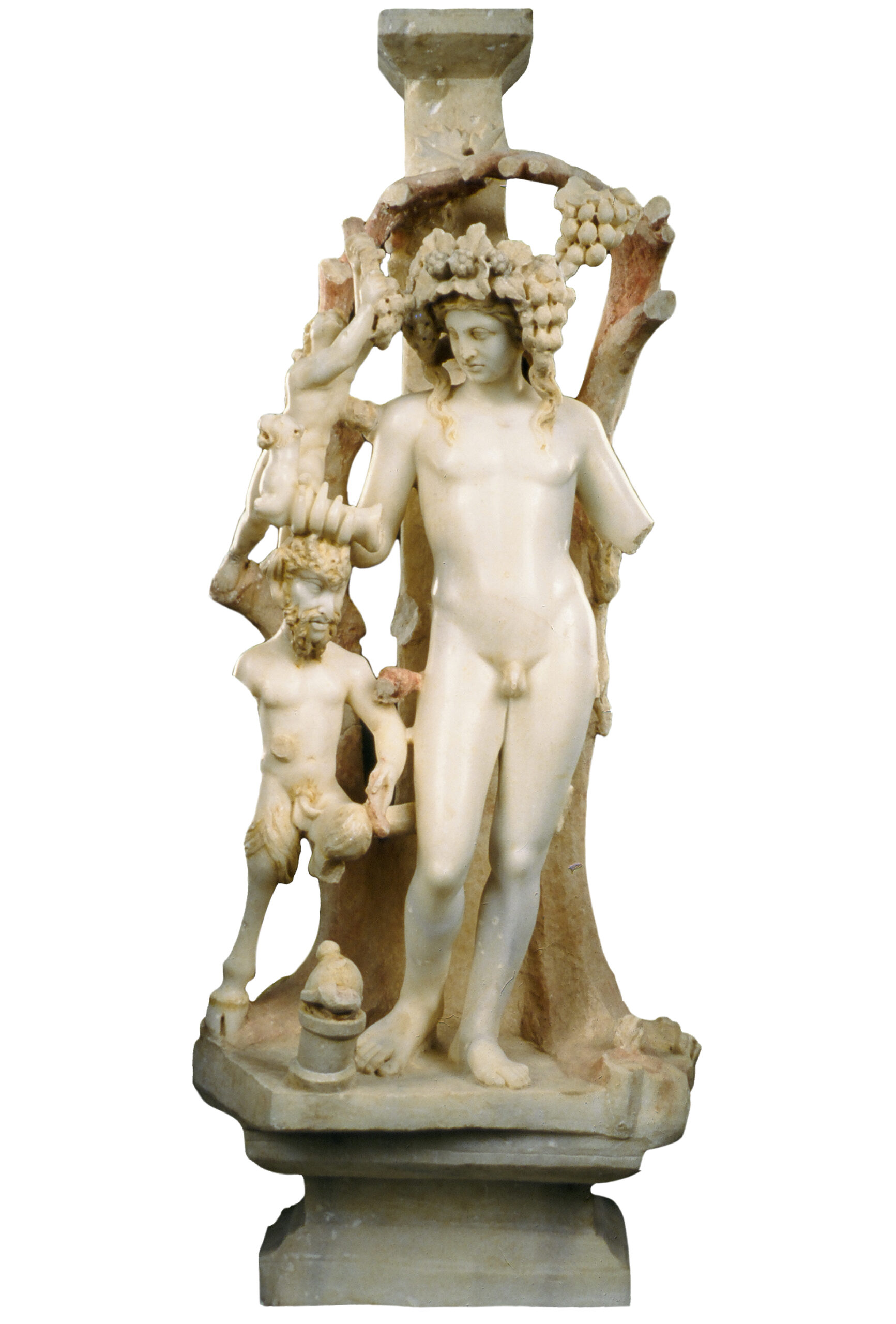Exhibit of the month
God Dionysos in Nature
Table Support with Dionysus and Pan
Hellenic National Archaeological Museum
Sculpture Collection Inv. Nr. Γ 5706
Provenance: Unknown
Measurements: Height: 1,275m.
Chronology: Roman period, about AD 170
Display place: Room 32
The support for a table with a single leg presented here, consists of a rectangular pillar standing on a base. The front of the pillar is adorned with a group of three statuettes, Dionysus, Pan and a young Satyr. The scene takes place in nature, the standing Dionysus is surrounded by a big vine with grapes. The god is depicted naked, beardless and his luxuriant long hair hangs in wavy tresses down his chest. On his head, he is wearing a heavy wreath of vine shoots with grapes and ivy leaves. He turns his head slightly to the left, gazing at Pan who is standing next to him, holding a lagobolon (hunting stub) in his left hand. In his right hand that rests on the head of the goat-footed god Pan, Dionysus holds a rhyton (a ritual vase) ending in a panther (sacred animal of the god). His hand rests on the head of the goat-footed god Pan, who is depicted much smaller. Before them lies a partly open circular basket from which a snake is emerging. Behind Pan, a small Satyr climbs up the vine holding a sickle in his right hand, in order to pick grapes. Hanging from the trunk of the vine are a lagobolon, a syrinx (pan-pipe) and a goatskin. Traces of red and yellow paint are preserved on various parts of the sculpture. The marble of the table support originates in Dokimeion of Asia Minor, which was an important artistic center for the production and export of sculptures and sarcophagus in Roman times. Another example of a table support from an Attic workshop, with a theme inspired by the Dionysus circle, depicts the group of a drunken Dionysus supported by a Satyr[1].
Dionysus is the god of vegetation and along with his thiasos, protectors of fertility, symbolize the reproductive forces of nature. According to the myth, the god visited the shrine of the attic hero Ikarios, now at the suburb Dionysos in the North of Attica, in order to teach the inhabitants of Attica viticulture and the production of wine. The so called “Ikarionrelief” [2] resonates the aforementioned mythological episode. On the red-figured crater dated about the middle of the 5th c. B.C., Satyrs are transporting and treading grapes in a wine press, while Dionysus is also depicted, standing between them. In a slab that formed the revetment of an altar, dated in Hellenistic times , two Silenoi are depicted treading grapes while in the center two Satyrs carry a calyx crater full of wine. After all, according to the ancient Greek notion “wine gladdens the heart of a man” and banishes worries.
[1]For Dionysus supported by a Satyr s. https://www.namuseum.gr/monthly_artefact/ataktoi-erotideis/
[2] https://www.namuseum.gr/en/monthly_artefact/ecstatic-drunkenness/
Dr. Wanda Papaefthymiou
Selected Bibliography
Ν. Kaltsas, Sculpture in the National Archaeological Museum (Athens 2002) 349, Kat. Nr. 739, 361 Kat. Nr. 773, 362-364 Kat. Nr. 776-777.
Th. Stefanidou-Tiveriou, Τραπεζοφόρα με πλαστική διακόσμηση. Η αττική ομάδα (1993) 42 note 100, 45 note 116, 47 note 131, 48, 56 note 226, 61 note 234.
E. Pochmarski, Das Bild des Dionysos in der Rundplastik der klassischen Zeit Griechenlands (Graz 1969).


